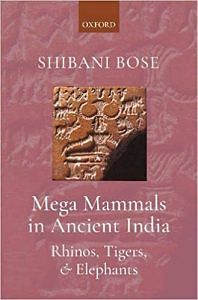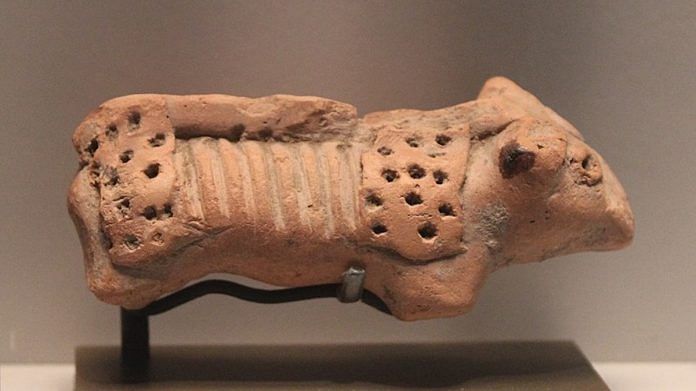The complexity in reconstructing ancient environments becomes apparent when we look at how the presence or absence of particular animal species has been widely treated as ecological markers. In the case of the Harappan civilization, for instance, the preponderance of the rhinoceros, and compared to it, the relative paucity of the horse can scarcely be missed. Manuel (2004–5, 21–6) set out to solve this puzzle, which according to him is intriguing given the fact that in any habitation, horses are likely to be more common than the rhinoceros. After illustrating how the animal ‘covered a large ground from association with deity, to entertainment and food’ (though apart from mentioning the retrieval of rhino bones from Harappan sites, he does not cite specific evidence for the animal being used as food), and in view of the numerous graphic depictions, Manuel argued that the animal could not have pervaded all these realms of Harappan life unless the Harappans were at least occasionally seeing it. The preponderance of the rhinoceros and the paucity of horses in the larger part of the Mature Harappan period was then attributed primarily to the humid Harappan environment which nurtured a ‘terra firma’ interspersed with patches of swamps and ponds besides grasslands and forests.
On the other hand, Chitalwala (1990, 80) has argued that though it is generally assumed that rhinos favour grassy lands with swamps, and do not prefer a dry environment, the animals actually exhibit a lot of flexibility when it comes to adapting to a particular ecological backdrop.
It is in view of such conflicting interpretations that it becomes crucial to turn to palaeoclimatic records in order to understand the factors that made for favourable rhino habitats in areas where the animal is now extinct. The available data, we know, has been used to support arguments both for and against climatic change within the zone of the Harappan civilization. While a detailed survey of the theories supporting either position would be out of context here, my emphasis will be on some of the evidence which points to an already arid climate during the Mature Harappan period. The attempt will be to reconstruct a landscape permitting the survival of the moisture-loving Indian rhinoceros in Harappan times.
Also read: India’s native horses disappeared by 8000 BC. But Rig Veda mentions them more than the cow
We know that while older theories suggested wetter conditions during Harappan times (Marshall 1931; Vats 1940), these were effectively critiqued by later archaeologists, hydrologists, and botanical experts (Raikes and Dyson 1961; Chowdhury and Ghosh 1951).
Nevertheless, the theory of a wetter climate was revived by Gurdip Singh (1970–1, 70–6), a plant palaeoecologist, when his sedimentological investigations of the northern salt lakes of Rajasthan (Lunkaransar, Didwana, and Sambar) showed significant fluctuations in precipitation based on pollen sequences dated by radiocarbon. These fluctuations were then correlated with the origin, efflorescence, and decline of the Harappan civilization. As per Singh’s pollen graph, the environmental sequence was grouped into six phases, of which we are concerned with Phase IV ascribed to c. 3000–1000 BCE. While sub-phase IVa (3000–1800 BCE) was associated with a sudden change to wetter climatic conditions, the onset of aridity during sub-phase IVb between c.1800–1500 BCE was argued to have resulted in the weakening of Harappan culture in the arid and semi-arid parts of north-west India.
Much has come along since then in terms of theories arguing for a wetter Harappan climate as well as an arid one. Michel Danino (2015, 40–2) gives an overview of the theories supporting either position. However, since my aim here is to juxtapose the evidence for the presence of the rhinoceros at Harappan sites with theories postulating an arid Harappan climate, the focus will be on the latter.
Based on a recalibration of the dates offered by Singh, Jim G. Shaffer and Diane A. Lichtenstein (1989, 120–1), for instance, argued that sub-phase IVa actually began at c. 4000 BCE and reached its mid-point by c. 3100 BCE, or 600 years before the generally accepted recalibrated date for the appearance of Harappan sites, c. 2500 BCE. The Harappan phenomena, therefore, according to them, appeared during a period of increasing aridity, coinciding with Singh’s sub-phase IVb, and not during a period of increased rainfall.
A later sedimentological study of lake Lunkaransar in the Thar Desert also argued that the environment and climate of the past 5000 C years were similar to those of the present (Enzel et al. 2000, 234). The data showed that the lake had completely dessicated around 4800 C yr BP, and that the Harappan civilization began and flourished in this region 1,000 years after the dessication of the lake during an arid climate (Enzel et al. 2000, 226). This chronology clearly defied any relation between the proposed drought that caused the dessication of the lakes and the collapse of the Indus culture, as the lakes dried out more than 1,500 years earlier. It was emphasized that the Indus civilization flourished mainly along rivers during times when north-western India experienced semi-arid climatic conditions similar to those at present (Enzel et al. 2000, 235).
Also read: New study shows climate change caused decline of flourishing Indus Valley Civilisation
Similarly, M.B. McKean, who studied the palynology of Balakot, also inferred that ‘there is nothing in the Balakot pollen data, which might suggest that the climate during the proto-historic period in Las Bela was decidedly wetter than at present’. This, therefore, serves as reinforcement for the evidence from Rajasthan when dates are calibrated, indicating that the mid-Holocene wet phase was more or less over by the time of the establishment of the Mature Harappan civilization of the second half of the third millennium BCE (cited in Madella and Fuller 2006, 1292).
From pollen sequences we can also turn to the study of soil stratigraphies. Ronald Amundson and Elise Pendall’s (1991, 13–27) study of the same from Harappa, for instance, is a case in point. As an indicator of pre-Harappan environmental conditions, basic conclusions of the laboratory tests revealed either a very arid, sparsely vegetated site (matching presumed latest Pleistocene conditions) or a nearly pure C4 flora, indicative of a tropical grassland (presumed early Holocene conditions).
Again, soil stratigraphies of the Upper Indus region showed that moister climates prevailed around 8000 to 5000 BCE, followed by a period of diminished precipitation and drier conditions (c. 5000–3000 BCE), the latter coinciding with the time when increasing numbers of settlements were present on the alluvial plains. The data for the period from c. 3300 to 1500/1300 BCE, and the peak period of occupation for settlement at Harappa and along the Beas (c. 3300–1900 BCE), suggested frequent fluctuations in climate and larger-scale stream migrations and precipitation levels than at other times. This was followed by a surge in precipitation, but by then the region had already been abandoned (Wright 2010, 39–40).
In view of these theories, it is possible to say that a substantial volume of evidence points to a dry climate during the pre-Harappan and Harappan phases. However, it is crucial to underline that by virtue of their riverine situation, several cities of the Indus civilization were in floodplain environments where rainfall was of minimal importance (Thapar 1977, 69). Cities such as Mohenjodaro, Chanhudaro, and Kot Diji prospered with Indus in their vicinity as did Harappa on the Ravi, Ropar on the banks of the Sutlej, Kalibangan on the Ghaggar/ Hakra, while Rangpur and Lothal benefitted from the Bhadar and Sabarmati (Lahiri 2000, 12). Hence, it would serve us well to remember that the majority of Harappan settlements flourished in alluvial terrains created by these mighty rivers.
In such a situation, the landscape must have been able to carry marshy-swampy patches for a species like the rhinoceros. Thus, despite climatic and tectonic fluctuations (the timings of which have been a matter of contention), it is not difficult to envision conditions permitting the survival of the animal at least along river valleys and in their vicinity.
 This excerpt from ‘Mega Mammals in Ancient India: Rhinos, Tigers, and Elephants’ by Shibani Bose has been published with permission from Oxford University Press.
This excerpt from ‘Mega Mammals in Ancient India: Rhinos, Tigers, and Elephants’ by Shibani Bose has been published with permission from Oxford University Press.



